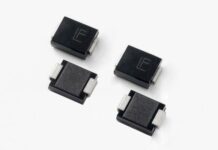Clacton-on-Sea, UK – Pickering Interfaces, the leading supplier of modular signal switching and simulation solutions for use in electronic test and verification, is expanding its range of supported protocols with 1000Base-T1 PXI and PXIe fault insertion switching modules. The compact, single-slot 40/42-203 and 40/42-204 modules deliver high performance, providing switching to 200V and 0.8A with typical differential bandwidths of 1.6GHz and 700MHz, respectively, both of which provide suitable overhead from the 1000Base-T1 specification. The modules feature PXI or PXIe control interface enabling flexibility in chassis selection.
The new 1000Base-T1 fault insertion modules are available with various channel counts and two fault bus connections. The 40-203 (PXI) and 42-203 (PXIe) units permit fault insertion on up to six channels of 2-wire connections, while the dual MUX 40-204 (PXI) and 42-204 (PXIe) provide fault insertion on one or two channels of 2-wire connections. Both models offer 100Ω controlled transmission line impedance signal paths. The 40/42-203 range uses high-quality reed relays designed for high-frequency applications, while the 40/42-204 range is based on high-quality electromechanical relays with both families offering a long service life.
For smaller test applications, both versions offer partially populated options for flexibility, with the 40/42-203 available with three channels and the 40/42-204 as a single channel. If the testing requirements increase, the fully populated modules double the channel count to six and two, respectively, in the same single chassis slot footprint. Both ranges use the MMCX connector interface, which permits a high channel count in a small panel area, although not differential.
Comments Steve Edwards, Switching Product Manager at Pickering Interfaces: “1000Base-T1 was initially developed for the automotive market, where the minimal weight of a single differential pair cable capable of high data rates was a requirement for modern automobiles. The standard has also been adopted for use in industrial control and building infrastructure Ethernet installations. Fault insertion enables the user to simulate cable breaks in either or both conductors per differential pair. In addition, the two fault bus connections allow the application of power rails such as Ground or Battery and the injection of other signals or a short-circuit condition to the differential pair. The 40/42-204 module provides a new feature in the Pickering fault insertion range with its ability to route the differential pair to/from external piece(s) of test equipment. Due to the variety of target industries, we believe that these fault insertion products will have many applications in various ATE systems.”
There are multiple vendors of connector systems designed for 1000Base-T1 applications, and the industry does not standardize on a particular series. For this reason, customers can advise their preferred connector range, and Pickering’s connector division, Pickering Connect, can manufacture custom adapters to convert from the module front panel MMCX connectors to the required 1000Base-T1 connector interface and standard accessories for the module connectors. The fault insertion modules are covered by Pickering’s standard three-year warranty.

















